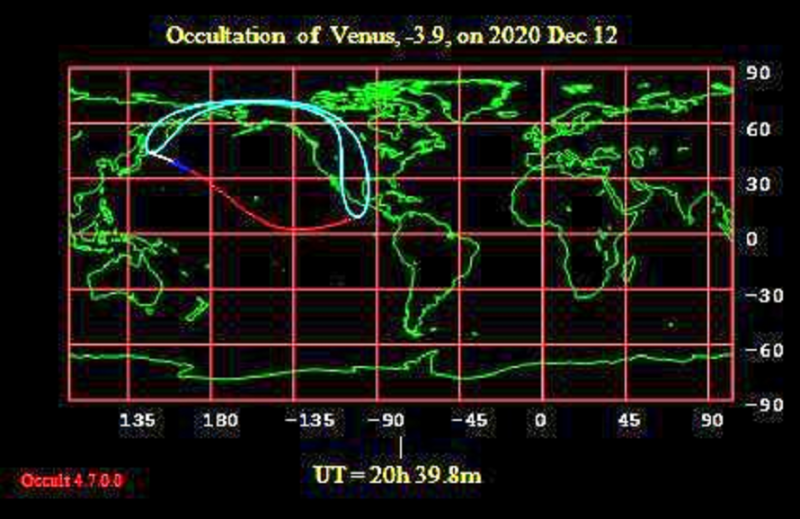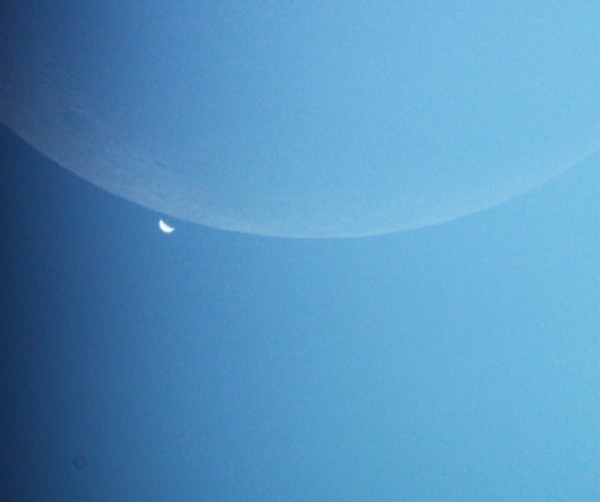
On the mornings of December 11, 12 and 13, 2020, look east before sunrise. The waning crescent moon and dazzling planet Venus will be beautiful in your early-morning sky. Note the illuminated or day side of the moon will be pointing right at Venus on December 11 and 12. The lit side of a waning crescent always points eastward, or in the moon’s direction of travel in front of the constellations of the zodiac.
Because the moon and Venus rank as the 2nd-brightest and 3rd-brightest celestial bodies, respectively, after the sun, you should have little trouble viewing these brilliant worlds in the glow of dawn.
While you’re viewing the morning tableau, check out the dark or nighttime side of the moon. You might see it as softly illuminated by earthshine – twice-reflected sunlight – that is, sunlight that’s bounced from Earth to the moon, and then from the moon back to Earth.
And the waning moon and Venus aren’t just pretty on these mornings. They’re a prelude of drama to come!
An occultation of Venus and a solar eclipse. As we speak, the moon is taking dead aim at both Venus and the sun. The moon will pass directly in front of the sun on December 14, causing a total solar eclipse visible from South America. Read more: South American total solar eclipse December 14
And – before the eclipse takes place – the moon will occult (pass in front of) Venus on December 12, though you have to be at the right spot on Earth to see it. For the most part, this lunar occultation of Venus happens in a daytime sky. It’ll happen in northeast Russia (early morning December 13), Hawaii (before midday December 12) and western North America (afternoon December 12). A twilight occultation can be seen only from extreme NE Russia and northern Alaska.
To see who will see the lunar occultation of Venus, see the worldwide map below. It’s via IOTA (International Occultation Timing Association).

The occultation of Venus takes place in western North America, Hawaii, the North Pacific Ocean and northeast Russia. The looped area over North America depicts where the beginning of the occultation can be seen but where the moon and Venus set before the occultation ends. The looped area over Russia shows where the occultation is in process at moonrise but where the end of the occultation is visible. Anyplace in between the looped areas can see the entire occultation. Red = daytime sky, blue = twilight sky and white = nighttime sky. Worldwide map via IOTA.
At the beginning of the occultation, Venus will slip behind the illuminated side of the moon then reappear from behind the moon’s dark side. Chances are that you may need an optical aid to witness this occultation.
Remember to use extreme caution because the moon and Venus will only be 25 degrees west of the sun.
For those living in the United States and Canada, we highly recommend Old Farmer’s Almanac for the rise/transit/set times for the moon and Venus in your sky. When the moon or Venus transits (crosses your meridian), it climbs up to its higest point for the day. Click here for the moon, and click here for Venus.
We provide our first example with Honolulu, Hawaii:
Moonrise: 4:55 a.m. local time (December 12)
Transit: 10:42 a.m. local time (December 12)
Moonset: 4:25 p.m. local time (December 12)Venus rise: 5:08 a.m. local time (December 12)
Transit: 10:41 a.m. local time (December 12)
Venus set: 4:15 p.m. local time (December 12)From Hawaii, the occultation occurs on and near the meridian at late morning December 12 (From Honolulu: 10:19 a.m. to 11:36 a.m. local time on December 12)
We give San Francisco, California, for our second example:
Moonrise: 4:53 a.m. local time (December 12)
Transit: 10:14 a.m. local time (December 12)
Moonset: 3:28 p.m. local time (December 12)Venus rise: 5:14 a.m. local time (December 12)
Transit: 10:14 a.m. local time (December 12)
Venus set: 3:24 p.m. local time (December 12)From California, the occultation occurs rather low in the southwest sky on the afternoon of December 12 (San Francisco: 1:11 p.m. to 2:18 p.m. local time on December 12)
We give Denver, Colorado, for our final example:
Moonrise: 4:43 a.m. local time (December 12)
Transit: 10:02 a.m. local time (December 12)
Moonset: 3:12 p.m. local time (December 12)Venus rise: 5:09 a.m. local time (December 12)
Transit: 10:10 a.m. local time (December 12)
Venus set: 3:10 p.m. local time (December 12)From Colorado, the occultation starts low in the southwest sky at late afternoon December 12 and the moon sets as the occultation is still in progress. (From Denver, the occultation starts at 2:29 p.m. local time on December 12)
We wish to remind you to use caution when looking at the moon and Venus through an optical aid. It may be helpful to have a partner shade out the sun with an umbrella, or some such thing, as you aim your binoculars at the skinny waning crescent moon in your daytime sky.

The moon approaches Venus just before lunar occultation of Venus on February 26, 2014. Photo by Ravindra Aradhya in Bangalore, India.
Bottom line: As seen from most everywhere worldwide, the moon will be to the west of (above) Venus at dawn December 12, and to the east of (below) Venus at dawn December 13. From North America and Hawaii, the moon will edge closer to Venus during the day on December 12, and will occult Venus during the afternoon hours from western North America. In Hawaii, the occultation will happen at late morning December 12. From western North America, you might be able to witness the lunar occultation of Venus during the daytime hours on December 12.
from EarthSky https://ift.tt/3gznVDy

On the mornings of December 11, 12 and 13, 2020, look east before sunrise. The waning crescent moon and dazzling planet Venus will be beautiful in your early-morning sky. Note the illuminated or day side of the moon will be pointing right at Venus on December 11 and 12. The lit side of a waning crescent always points eastward, or in the moon’s direction of travel in front of the constellations of the zodiac.
Because the moon and Venus rank as the 2nd-brightest and 3rd-brightest celestial bodies, respectively, after the sun, you should have little trouble viewing these brilliant worlds in the glow of dawn.
While you’re viewing the morning tableau, check out the dark or nighttime side of the moon. You might see it as softly illuminated by earthshine – twice-reflected sunlight – that is, sunlight that’s bounced from Earth to the moon, and then from the moon back to Earth.
And the waning moon and Venus aren’t just pretty on these mornings. They’re a prelude of drama to come!
An occultation of Venus and a solar eclipse. As we speak, the moon is taking dead aim at both Venus and the sun. The moon will pass directly in front of the sun on December 14, causing a total solar eclipse visible from South America. Read more: South American total solar eclipse December 14
And – before the eclipse takes place – the moon will occult (pass in front of) Venus on December 12, though you have to be at the right spot on Earth to see it. For the most part, this lunar occultation of Venus happens in a daytime sky. It’ll happen in northeast Russia (early morning December 13), Hawaii (before midday December 12) and western North America (afternoon December 12). A twilight occultation can be seen only from extreme NE Russia and northern Alaska.
To see who will see the lunar occultation of Venus, see the worldwide map below. It’s via IOTA (International Occultation Timing Association).

The occultation of Venus takes place in western North America, Hawaii, the North Pacific Ocean and northeast Russia. The looped area over North America depicts where the beginning of the occultation can be seen but where the moon and Venus set before the occultation ends. The looped area over Russia shows where the occultation is in process at moonrise but where the end of the occultation is visible. Anyplace in between the looped areas can see the entire occultation. Red = daytime sky, blue = twilight sky and white = nighttime sky. Worldwide map via IOTA.
At the beginning of the occultation, Venus will slip behind the illuminated side of the moon then reappear from behind the moon’s dark side. Chances are that you may need an optical aid to witness this occultation.
Remember to use extreme caution because the moon and Venus will only be 25 degrees west of the sun.
For those living in the United States and Canada, we highly recommend Old Farmer’s Almanac for the rise/transit/set times for the moon and Venus in your sky. When the moon or Venus transits (crosses your meridian), it climbs up to its higest point for the day. Click here for the moon, and click here for Venus.
We provide our first example with Honolulu, Hawaii:
Moonrise: 4:55 a.m. local time (December 12)
Transit: 10:42 a.m. local time (December 12)
Moonset: 4:25 p.m. local time (December 12)Venus rise: 5:08 a.m. local time (December 12)
Transit: 10:41 a.m. local time (December 12)
Venus set: 4:15 p.m. local time (December 12)From Hawaii, the occultation occurs on and near the meridian at late morning December 12 (From Honolulu: 10:19 a.m. to 11:36 a.m. local time on December 12)
We give San Francisco, California, for our second example:
Moonrise: 4:53 a.m. local time (December 12)
Transit: 10:14 a.m. local time (December 12)
Moonset: 3:28 p.m. local time (December 12)Venus rise: 5:14 a.m. local time (December 12)
Transit: 10:14 a.m. local time (December 12)
Venus set: 3:24 p.m. local time (December 12)From California, the occultation occurs rather low in the southwest sky on the afternoon of December 12 (San Francisco: 1:11 p.m. to 2:18 p.m. local time on December 12)
We give Denver, Colorado, for our final example:
Moonrise: 4:43 a.m. local time (December 12)
Transit: 10:02 a.m. local time (December 12)
Moonset: 3:12 p.m. local time (December 12)Venus rise: 5:09 a.m. local time (December 12)
Transit: 10:10 a.m. local time (December 12)
Venus set: 3:10 p.m. local time (December 12)From Colorado, the occultation starts low in the southwest sky at late afternoon December 12 and the moon sets as the occultation is still in progress. (From Denver, the occultation starts at 2:29 p.m. local time on December 12)
We wish to remind you to use caution when looking at the moon and Venus through an optical aid. It may be helpful to have a partner shade out the sun with an umbrella, or some such thing, as you aim your binoculars at the skinny waning crescent moon in your daytime sky.

The moon approaches Venus just before lunar occultation of Venus on February 26, 2014. Photo by Ravindra Aradhya in Bangalore, India.
Bottom line: As seen from most everywhere worldwide, the moon will be to the west of (above) Venus at dawn December 12, and to the east of (below) Venus at dawn December 13. From North America and Hawaii, the moon will edge closer to Venus during the day on December 12, and will occult Venus during the afternoon hours from western North America. In Hawaii, the occultation will happen at late morning December 12. From western North America, you might be able to witness the lunar occultation of Venus during the daytime hours on December 12.
from EarthSky https://ift.tt/3gznVDy

Aucun commentaire:
Enregistrer un commentaire